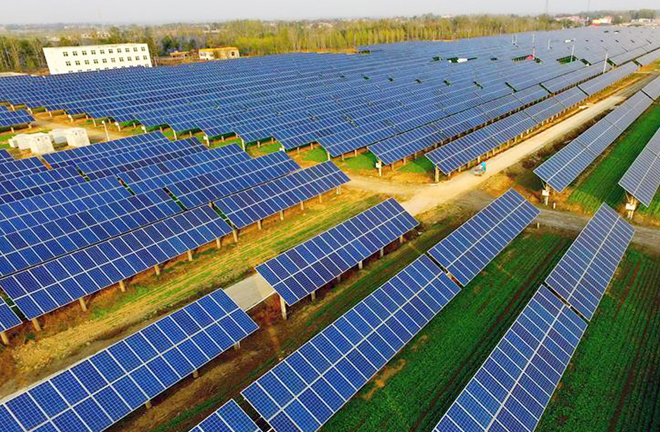Rural industrial development key to poverty alleviation

A poverty alleviation project using photovoltaic power generation in Guanzhai Village, Xingtai City, Hebei Province Photo: Yang Shiyao/XINHUA
At present, it is an important task for China to effectively combine efforts of poverty alleviation with rural vitalization. Industrial development in rural areas is the key to fully winning the battle against poverty and achieving rural vitalization. It is conducive to consolidating the achievements of poverty alleviation, cultivating a long-term poverty alleviation mechanism, promoting the development of agriculture and rural areas, and accelerating the overall vitalization of rural areas.
Shi Dan, a research fellow and director of the Institute of Industrial Economics at the Chinese Academy of Social Sciences (CASS), said that in order to reduce poverty, industrial development in rural areas should first support the construction of a modernized system of agriculture. Only by realizing agricultural modernization can we achieve rural economic vitalization and lay a solid foundation for people to strive for better lives. Furthermore, industrial poverty alleviation should try to increase the added value of agriculture through developing new economies, new models and new forms of industry, thereby increasing rural people’s income and alleviating poverty. In addition, industrial development enables rural areas, agriculture and rural people to increase their development capabilities and paths to prosperity. It helps transform the backward mode of agricultural production with modern technology and integrate the rural economy into the modern economic system.
Li Jianjun, a professor from the College of Humanities and Development Studies at China Agricultural University, said that industrial development in rural areas is a fundamental way to encourage poverty alleviation and rural vitalization. Developing rural industries with rural and agricultural resources and rural talent is the endogenous driving force for rural development. In the meantime, we should focus on building an urban-rural integrated development mechanism and policy system, realize equal access to public services in urban and rural areas, and accelerate the pace of agricultural and rural modernization.
Li Guoxiang, a research fellow from the Rural Development Institute at CASS, said that the goal of rural industrial development is to create resources to alleviate poverty instead of simply moving resources to poor areas, enhance the endogenous momentum of development of poverty-stricken areas, and facilitate stable employment and sustainable income for people in those areas. This focus helps form a stable and long-term mechanism for poverty alleviation, promoting rural vitalization.
Shi Yungui, dean of the School of Public Administration at Sichuan University, said that poverty-stricken areas should develop traditional industries with their own characteristics, thus creating jobs for the unprivileged and raising income. While meeting the requirements of green development, different places should choose to develop characteristic agriculture and husbandry, eco-tourism, ethnic handicraft industries, labor-intensive processing industries and service industries according to their local conditions.
The vitalization of rural industries should be based on local natural resources and industrial foundations, excavating relevant agricultural cultural heritage and indigenous knowledge, building an innovative service system of industries with local characteristics and regional industries, and forging nationally renowned brands, Li Jianjun added.
Li Guoxiang suggested cultivating high-quality and efficient industries with distinctive features, expanding the industrial chain, and providing high-quality products and services. We should also improve the consumption mechanisms of anti-poverty products, broaden sales channels for agricultural products of poverty-stricken areas, and stimulate society to participate in poverty alleviation through consumption, Li concluded.
Rural vitalization does not just mean increasing the capacity of agricultural production and rural people’s income. There is also the need to vigorously develop the service industry, strengthen infrastructure construction, improve rural people’s level of education, expand their access to information, and strengthen rural economic links with the outside world, Shi Dan continued.
Shi Yungui said that as Chinese President Xi Jinping has said, “lucid waters and lush mountains are valuable assets.” We need to promote the integration of the primary, secondary and tertiary industries in rural areas through green development, preserve the natural ecological environment to the greatest extent, and develop green industries including the circulation of cultivation and feeding, deep processing of agricultural products, tours and sightseeing, and development of healthcare industries. Moreover, we should, through technological innovation, promote the integration of the three industries, extend the industrial chain, and increase the added value of agricultural and sideline products.
We need to comprehensively promote the rural industrial revolution and accelerate the pace of integration of the three industries in poverty-stricken areas by transforming resources into assets, funds into money paid for shares, and rural people into shareholders. In addition, we should further enrich the forms of integration, and accelerate the cultivation of new industries and new business types such as rural leisure tourism and digital agriculture, Shi Yungui added.
edited by YANG LANLAN

 PRINT
PRINT CLOSE
CLOSE